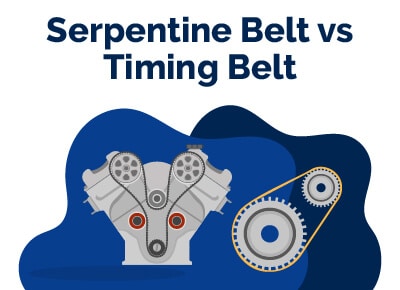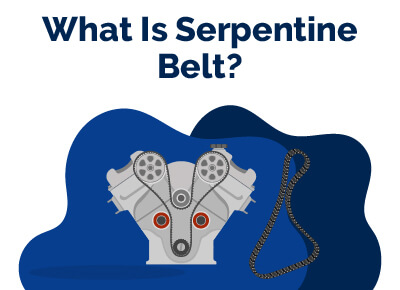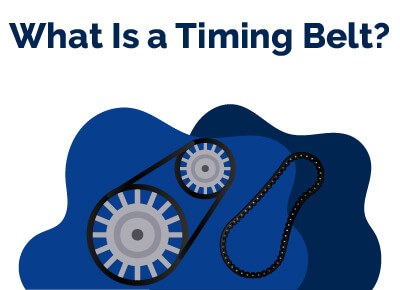Serpentine Belt Vs Timing Belt (Key Differences)
April 26, 2023


Chris is Head of Content for FindTheBestCarPrice and is based out of Philadelphia, PA. As a seasoned automotive industry analyst and car enthusiast, he ensures the highest level of quality across all our content and curates our picks for the best deals each month.
Chris studied information systems and marketing at Drexel University and writes about a wide range of topics ranging from car buying tips to troubleshooting common mechanical issues.
When he’s not thinking about cars, he likes to stay in with his dog and make an “attempt” to finish a crossword puzzle (he’s not quite at the Saturday/Sunday level…yet). As a former cheesemonger, Chris still has a “sharp” passion for all things cheese, and his fridge is always loaded with it!
Chris also has a passion for things that go fast, and drones are no exception. He spends some of his time writing for Dronesourced.
There are different belts in every vehicle and they all perform different functions. The serpentine belt vs timing belt perform the most important belt-related functions in the engine bay.
The serpentine belt is a “belt” that connects and drives different mechanical components in the engine bay. It is easily visible - once you pop the engine bay, the serpentine belt(s) would be right there starring at you. But the timing belt is not easily visible; it connects the camshaft and crankshaft.
Understanding the difference between serpentine belts and timing belts can be quite confusing, but this serpentine belt and timing belt comparison would help you note the differences between these two most important belts in your car’s inner chambers.
Table of Contents
What Is the Serpentine Belt?
 It is called a “serpentine” belt because it’s smooth and looks pretty much like a black “snake” curled around different pulleys/components in the engine bay. This belt is visible immediately after you open the engine bay. Yes, it is an important belt, and if it breaks or loosens, your engine stands at great risk.
It is called a “serpentine” belt because it’s smooth and looks pretty much like a black “snake” curled around different pulleys/components in the engine bay. This belt is visible immediately after you open the engine bay. Yes, it is an important belt, and if it breaks or loosens, your engine stands at great risk.
The serpentine belt connects the alternator, air conditioning compressor, power steering pump, and water pump (in some vehicles). The serpentine belt runs continuously – from the car cracks up until you turn it off completely. If the serpentine belt doesn’t turn, the components it connects won’t run.
In other words, a bad serpentine belt would probably stop the engine from starting since connects the alternator and power steering pump. Well, serpentine belts don’t fail easily, you’d notice some signs of failure whenever it starts going bad or loosens up.
What Is the Timing Belt?
 This belt is not easily visible; it is located deeper inside the engine, or even beneath the engine. It connects just two components - the crankshaft and the camshaft. These two “shafts” connected by the timing belt are very important if your car must drive.
This belt is not easily visible; it is located deeper inside the engine, or even beneath the engine. It connects just two components - the crankshaft and the camshaft. These two “shafts” connected by the timing belt are very important if your car must drive.
Without the timing belt rotating the crankshaft and camshaft, apparently, your car won’t drive an inch. As the name implies, the “Timing” belt synchronizes the movement/rotation of the crankshaft with the camshaft to keep your car running. If the crankshaft and camshaft don’t rotate in a synchronous order, your car won’t drive.
Also, the timing belt is a bit rough in appearance; it doesn’t appear as smooth as the serpentine belt. The timing belt has “teeth” all around it. Below are the differences between the timing belt and serpentine belt.
Serpentine Belt Vs Timing Belt
Most cars have a serpentine belt and a timing belt; the two belts must be present and work fine before the car can move. Some new vehicles only come with a serpentine belt. Notwithstanding, both timing belts and serpentine belts use tensioners to stay tight.
That said, below are the differences between serpentine belt and timing belt:
1. Appearance
The first visible difference between these two belts is their appearance. A serpentine belt looks smooth and longer, while a timing belt has “teeth” on one side and looks smooth on the other side.
Also, a timing belt is wider than a serpentine belt but shorter in length. With this explanation, mere looking at the belts, you would be able to tell which is serpentine and which is the timing belt.
2. Location in the Engine Bay
The serpentine belt is what you’d immediately see when you open the engine bay. It connects and powers 4 - 5 crucial components in the engine area. On the other hand, for you to see the timing belt, you need to look deep into the engine bay or take a look from under the vehicle.
With this knowledge, you can easily tell which belt is giving you issues. If you opened the engine bay and the first belt you saw seemed loose or broken; that’s the serpentine belt and it needs to be fixed immediately. But, if the serpentine belt looks good, check from under to see if the timing belt is the culprit.
3. Number of Connected Pulleys/Components
The timing belt connects only the camshaft and crankshaft, which must move synchronously for a car engine to run. In contrast, the serpentine belt connects more pulleys and components.
Things to Note:
For vehicles that come with these two belts, it is important that both belts are functioning well. If any of them fails, your engine is at great risk. A broken/bad timing belt would force the valves to stuck open and this could lead to the damage of the valves, pistons, and/or cylinder head.
On the other hand, when the serpentine belt breaks or loosens up, everything that’s driven by the belt would stop functioning and that’s a big risk for your car’s engine. Hence, it is advisable to always check on these belts. Serpentine and timing belts typically last for 60,000 – 100,000 miles.
Oil leaks, coolant leaks, and severe overheating are among the common reasons for serpentine and timing belt damage. So, if you detect a leak in the engine bay, try to fix the leaking component as early as possible.
Summary
Serpentine vs timing belt is quite an easy comparison. A timing belt is toothed and shorter while a serpentine belt is smoother and longer.
Also, not all cars come with a timing belt, but all cars come with a serpentine belt. Both belts are affected by the same scenarios: overheating, oil leak, or coolant leak.
Best Car Deals by Category
Posted in Car Troubleshooting |




